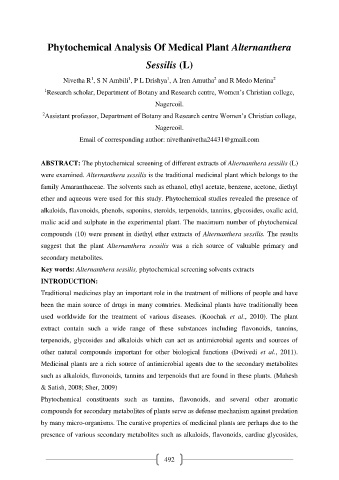Page 502 - e-Book
P. 502
Phytochemical Analysis Of Medical Plant Alternanthera
Sessilis (L)
1
1
2
1
2
Nivetha R , S N Ambili , P L Drishya , A Iren Amutha and R Medo Merina
1 Research scholar, Department of Botany and Research centre, Women’s Christian college,
Nagercoil.
2 Assistant professor, Department of Botany and Research centre Women’s Christian college,
Nagercoil.
Email of corresponding author: nivethanivetha24431@gmail.com
ABSTRACT: The phytochemical screening of different extracts of Alternanthera sessilis (L)
were examined. Alternanthera sessilis is the traditional medicinal plant which belongs to the
family Amaranthaceae. The solvents such as ethanol, ethyl acetate, benzene, acetone, diethyl
ether and aqueous were used for this study. Phytochemical studies revealed the presence of
alkaloids, flavonoids, phenols, saponins, steroids, terpenoids, tannins, glycosides, oxalic acid,
malic acid and sulphate in the experimental plant. The maximum number of phytochemical
compounds (10) were present in diethyl ether extracts of Alternanthera sessilis. The results
suggest that the plant Alternanthera sessilis was a rich source of valuable primary and
secondary metabolites.
Key words: Alternanthera sessilis, phytochemical screening solvents extracts
INTRODUCTION:
Traditional medicines play an important role in the treatment of millions of people and have
been the main source of drugs in many countries. Medicinal plants have traditionally been
used worldwide for the treatment of various diseases. (Koochak et al., 2010). The plant
extract contain such a wide range of these substances including flavonoids, tannins,
terpenoids, glycosides and alkaloids which can act as antimicrobial agents and sources of
other natural compounds important for other biological functions (Dwivedi et al., 2011).
Medicinal plants are a rich source of antimicrobial agents due to the secondary metabolites
such as alkaloids, flavonoids, tannins and terpenoids that are found in these plants. (Mahesh
& Satish, 2008; Sher, 2009)
Phytochemical constituents such as tannins, flavonoids, and several other aromatic
compounds for secondary metabolites of plants serve as defense mechanism against predation
by many micro-organisms. The curative properties of medicinal plants are perhaps due to the
presence of various secondary metabolites such as alkaloids, flavonoids, cardiac glycosides,
492

